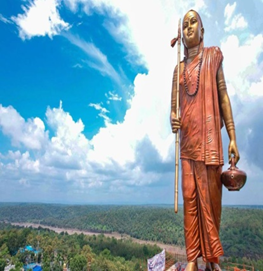

22nd September 2023 (9 Topics)
Context
Madhya Pradesh Chief Minister Shivraj Singh Chouhan unveiled a 108-foot-tall statue of the 8th-century spiritual leader Adi Shankaracharya naming it as ‘Statue of Oneness’ in Omkareshwar.
About the Statue:
- The ‘Statue of Oneness’, depicts Shankaracharya as a 12-year-old child when he is said to have visited Omkareshwar, which is one among the twelve Jyotirlinga shrines.
- The statue weighs 100 tonnes and was conceptualised by an Indian team of artists, a sculptor and engineers.
- The metal casting was done in China’s Nanchang city and shipped to Mumbai in several batches.
- The idol, installed on a 75-foot platform, is made up of bronze that contains 88% copper, 4% zinc and 8% tin.
- Its internal structure is made-up of high-quality steel.
- The design for the statue was conceptualised founding inspiration in Raja Ravi Verma’s depiction of Shankaracharya.
Who was Adi Shankaracharya?
- Adi Shankaracharya is generally considered an eighth-century religious teacher.
- According to a commonly held view, Adi Shankaracharya was born in 788 AD.
- Adi Shankara, as he is popularly known among his followers, was born in Kalady village -now a small town in the Ernakulam district - situated on the bank of a river of the same name in Kerala.
- He was an exceptional child as Adi Shankara had become fluent in Sanskrit by the age of two. By four, he was comfortably reciting scriptures including Vedas.
- The burning quest for attaining superior knowledge from an early age pushed Adi Shankara to leave his home and set on the search for a guru.
- His quest ended with Govind Bhagvatpad at Omkareshwar (Madhya Pradesh) on the bank of the Narmada River.
- Adi Shankara excelled under the tutelage of Govind Bhagvatpad, who instructed him to write commentaries on scriptures on completion of his learning. Adi Shankara was just 12 at the time.
- Following his guru's command, Adi Shankara wrote commentaries explaining the subtle meanings hidden in scriptures.
- To his ardent followers, Adi Shankaracharya was an incarnation of Lord Shiva, who came to the earth for 32 years.
|
Jyotirlinga |
Location |
State |
|
Somnath |
Veraval, Saurashtra |
Gujarat |
|
Mallikarjuna |
Srisailam |
Madhya Pradesh |
|
Mahakaleshwar |
Ujjain |
Madhya Pradesh |
|
Omkareshwara |
Khandwa |
Madhya Pradesh |
|
Kedarnath |
Kedarnath |
Uttarakhand |
|
Bhimashankar |
Khed Taluka, Pune |
Maharashtra |
|
Vishweshwara |
Varanasi |
Uttar Pradesh |
|
Trayambakeshwar |
Trimbak |
Maharashtra |
|
Nageshwara |
Jamnagar |
Gujarat |
|
Baidyanath |
Deoghar |
Jharkhand |
|
Rameshwaram |
Rameshwaram |
Tamil Nadu |
|
Grishneshwar |
Ellora |
Maharashtra |
Religion and Philosophy:
- Adi Shankaracharya championed the Advait branch of philosophy that declared that god and humans were not two. He then set out to spread the message of his guru.
- From the age of 16 to 32, Adi Shankaracharya traveled across the length and breadth of India with the message of Vedas.
- He pronounced that 'Brahman or pure consciousness is the absolute reality that is attainable by human beings and that the material world is an illusion.
- He established his supremacy in religion and philosophy in debating duels with experts and chief of ashram after ashram from north to south and east to west.
- The defeat would end up hitherto expert philosophers accepting young Adi Shankara as their guru ad accepting his interpretation of the scriptures.
Important Literary work
- Adi Shankaracharya wrote 18 commentaries on the scriptures including the Brahma Sutras, the Bhagavad Gita, and 12 major Upanishads.
- He wrote about two dozen books elucidating the fundamentals of the Advaita Vedanta philosophy.
- Some of these books are Viveka Chudamani, Atma Bodha, Vaakya Vritti, and Upadesa Sahasri.
- Adi Shankaracharya is credited to have composed 72 devotional and meditative hymns such as Soundarya Lahari, Sivananda Lahari, Nirvana Shalkam, Maneesha Panchakam.
Important Ashram founded by Adi Shankaracharya
- Having established his superiority among all exponents of religion and philosophy of the time, Adi Shankaracharya founded four ashrams in the four corners of the country–
- Badrinath for Atharva Veda.
- Puri for Rig Veda
- Dwaraka for Sama Veda
- Sringeri for Yajur Veda
- These were the centres to elucidate the essence of Advaita philosophy.
|
What is the Kedarnath Connection?
|

